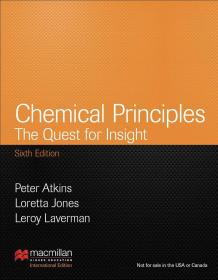
现货Chemical Technology: Principles & Applications[9781682510711]
¥ 1818 九五品
仅1件
作者Pier-Luc Tremblay, Tian Zhang
出版社Intelliz Press LLC
ISBN9781682510711
出版时间2016-01
装帧精装
纸张其他
正文语种英语
上书时间2023-08-08
- 最新上架
商品详情
- 品相描述:九五品
- 商品描述
- The Chemical Technology prepares graduates to enter the chemical field in any one of a variety of capacities: chemical research technician, laboratory assistant, chemical production technician, junior chemist or analytical technician. Chemical technicians play a vital role in a variety of industries by working with chemists and chemical engineers to develop, test, and manufacture chemical products. These technicians are highly skilled scientific professionals who are critical members of scientific teams that conduct much of the hands-on work that is required. Some technicians assist senior researchers in the laboratory, but many work independently to collect valuable information for review. Chemical technicians work in laboratories, making sure that processes are carried out safely, cost-effectively, and according to the highest professional standards. Chemical Technology Principles & Applications is structured to develop a fundamental understanding of general, organic and analytical chemistry, with emphasis on laboratory applications and techniques. In first chapter, we discuss the future of MES and the challenges that lie ahead for its development into a mature technology. Second chapter highlights on grand challenges in chemical engineering. Third chapter gives an overview for a successful analytical method of the main components of an alkaline texturing bath by titration, HPLC, surface tension and NIR spectrometry. Fourth chapter gives an overview on the basics of reaction kinetics for chemical reaction engineering. Fifth chapter gives an overview on heterogeneous catalysis. Sixth chapter provides a theoretical study of two novel concept systems for maximum thermal-chemical conversion of biomass to hydrogen. Seventh chapter intends to characterize the rods grown with this practical method in order to know their properties and propose suitable applications. Eighth chapter reviews on pre-treatment of high free fatty acids oils by chemical re-esterification for biodiesel production. Ninth chapter presents a comprehensive review of various traditional systems of crude oil distillation column design, modeling, and simulation, optimization and control methods. Tenth chapter focuses on alkaline and alkaline-earth ceramic oxides for co2 capture, separation and subsequent catalytic chemical conversion. Eleventh chapter reveals on the fundamentals of chemical reaction engineering. The aim of twelfth chapter is to evaluate the thermal characterization of verapamil hydrochloride using a variety of techniques including TG, DSC, Fourier transform infrared spectroscopy (FTIR), liquid chromatography, and X-ray diffraction (XRD). Thirteenth chapter presents a novel technique based on coal gasification integrated with chemical looping air separation (CLAS) by thermodynamic methods. Fourteenth chapter reviews on industry dynamics in pharmaceuticals and fifteenth chapter explores on chemical technology and chemical engineering. Last chapter highlights on sustainability assessment of chemical processes.
相关推荐
-

The Techn
全新保定
¥ 63.50
-

The Techn
全新北京
¥ 63.50
-

The Techn
全新保定
¥ 63.50
-

TECHN0
八五品天津
¥ 10.00
-

TECHNⅠC,说明书
八品开封
¥ 20.00
-
![现货Chemical Thermodynamics[9781789223460]](https://www0.kfzimg.com/sw/kfz-cos/kfzimg/17733071/7b52de077a8646fc_s.jpg)
现货Chemical Thermodynamics[9781789223460]
九五品上海
¥ 1594.00
-
![现货Chemical Equilibrium[9781682501672]](https://www0.kfzimg.com/sw/kfz-cos/kfzimg/17733071/73be66a2ae165ecc_s.jpg)
现货Chemical Equilibrium[9781682501672]
九五品上海
¥ 1434.00
-
![现货Chemical Dynamics[9781682501733]](https://www0.kfzimg.com/sw/kfz-cos/kfzimg/17733071/97e7e8ef5332a586_s.jpg)
现货Chemical Dynamics[9781682501733]
九五品上海
¥ 64514.00
-

现货 Chemical Principles.
九五品上海
¥ 409.00
-
![现货Chemical Energy Storage[9783110608434]](https://www0.kfzimg.com/sw/kfz-cos/kfzimg/17733071/258d44677425dd90_s.jpg)
现货Chemical Energy Storage[9783110608434]
九五品上海
¥ 925.00
— 没有更多了 —
![现货Chemical Technology: Principles & Applications[9781682510711]](https://www0.kfzimg.com/sw/kfz-cos/kfzimg/17733071/97376d13e8e7176e_b.jpg)

![现货Materials and Technologies of Modern Production[9783036401683]](https://www0.kfzimg.com/sw/kfz-cos/kfzimg/17733071/5fd2824531e165d7_s.jpg)
![现货Introduction to Container Ship Operations and Onboard Safety[9781032155425]](https://www0.kfzimg.com/sw/kfz-cos/kfzimg/17733071/58b7ff43ef7909ee_s.jpg)
![现货Electrophosphorescent Materials and Devices[9789814877343]](https://www0.kfzimg.com/sw/kfz-cos/kfzimg/17733071/18cc1d77bcb7b488_s.jpg)
![现货Organic Semiconductors for Optoelectronics[9781119146100]](https://www0.kfzimg.com/sw/kfz-cos/kfzimg/17733071/24c85a750c708964_s.jpg)
![现货Advances in Food Rheology and Its Applications[9780081004319]](https://www0.kfzimg.com/sw/kfz-cos/kfzimg/17733071/e0c11603c9119d4d_s.jpg)
![现货Advanced Materials and Sustainable Technologies[9783035727562]](https://www0.kfzimg.com/sw/kfz-cos/kfzimg/17733071/dced675333874c48_s.jpg)
![现货Advanced Materials and Manufacturing Engineering II[9783035712681]](https://www0.kfzimg.com/sw/kfz-cos/kfzimg/17733071/660ccfae75fa8d3e_s.jpg)
![现货Materials in Machinery and Construction[9783035718119]](https://www0.kfzimg.com/sw/kfz-cos/kfzimg/17733071/6f402060775e9daa_s.jpg)
![现货Cereal Grain Quality (Softcover Reprint of the Original 1st 1996)[9789401071772]](https://www0.kfzimg.com/sw/kfz-cos/kfzimg/17733071/f93ca1c96a97403a_s.jpg)
![现货Chemical Technology: Principles & Applications[9781682510711]](/dist/img/error.jpg)
以下为对购买帮助不大的评价